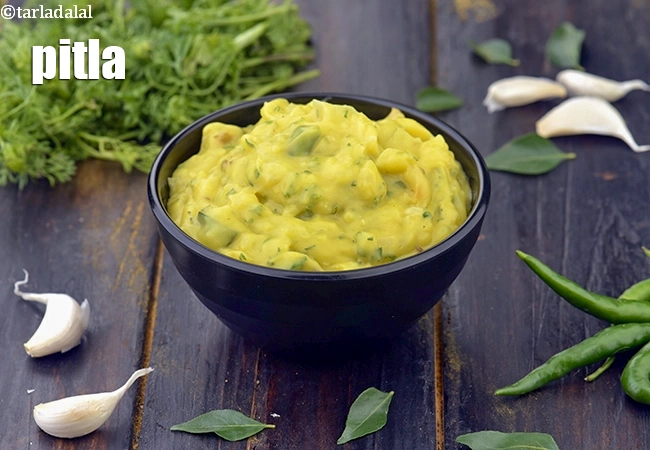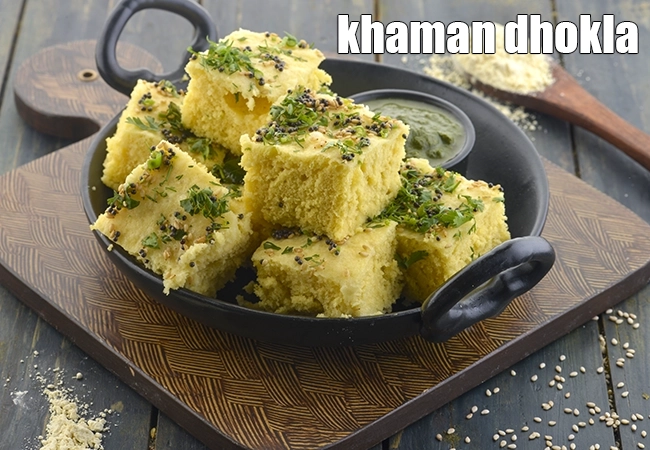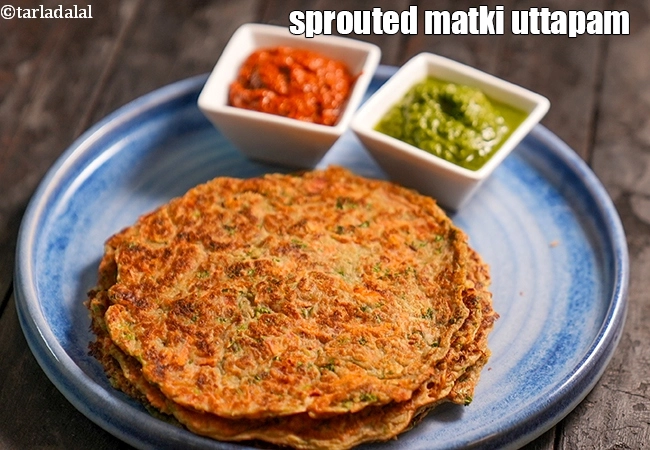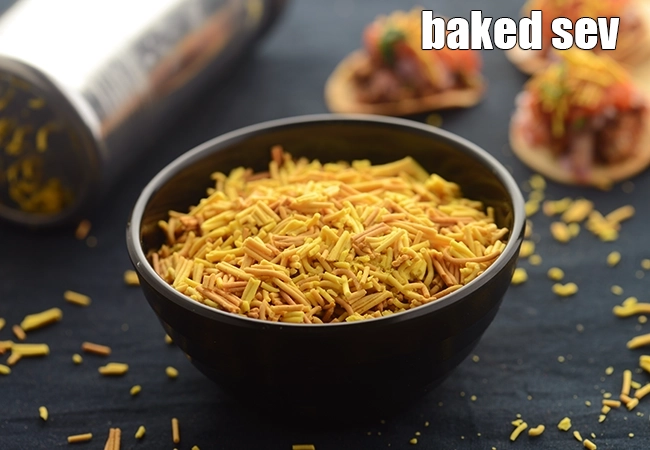besan

Table of Content
What is besan, chana dal flour, bengal gram flour?
Besan is gluten-free flour used in the preparation of several sweet and savoury snacks including the world-famous laddoo! The super-fine flour prepared from pure chana dal, has an earthy aroma and binding nature that makes it a key ingredient in the batter used for preparing onion pakodas, traditional potato and vegetable bhajiyas, and some sweet dishes. It is also used in many desserts and battered dishes all over the world.
Also Known as
Bengal gram flour, Chana dal flour
How to select besan, chana dal flour, bengal gram flour
• Choose yellow-coloured flour that is clean and free from insects.
• Purchase coarsely or finely ground besan, as desired.
• Check the label and buy the freshest stock as it imbibes a rancid smell over time.
Culinary Uses of besan, chana dal flour, bengal gram flour in Indian Cooking
Maharashtrian pitla | besan pitla | Maharashtrian pitla with chawal bhakri | Pitla is a very famous Maharashtrian food, falls under the category of their comfort food. Not only Maharashtrians but many Indian households have pitla in their weekly menu.

• It is a versatile, gluten-free flour that is rich in protein.
khaman dhokla | Gujarati khaman dhokla | steamed, soft khaman dhokla

• It is used for making onion, potato or banana fritters, which are sliced vegetables, dipped in a besan-based batter and deep-fried to a beautiful golden brown. They are known by names like pakoda and bhajiya, and loved by almost all Indians. They are made at home too, but far more popular at street side vendors! These fritters are a great accompaniment to tea.
• It is the base for other savoury snacks like dhokla, bonda, and sev, and used in making sweets like laddoo and Mysore pak.
• It forms the base for vegetarian omelettes.
• Besan is also blended into koftas and it is an important ingredient in kadhi, a yogurt-based soup that is frequently made in north Indian homes.
• Besan pancake is a quick and easy snack, made with a batter of besan perked up with spices of your choice, and finely diced green chillies, onions, tomatoes and optionally ginger too.
• Besan is used as a thickener in soups and sauces of all types, and may be used as egg is used in western cuisine to bind ingredients together.
• In other cuisines, the versatile flour is sometimes used in batters, soups, desserts and some bread too.
sprouted matki uttapam recipe | sprouted matki vegetable pancake | healthy matki vegetable chilla

How to store besan, chana dal flour, bengal gram flour
• Store in a clean, dry and airtight container away from moisture, sunlight and infestation.
• If you wish to store for more than a month, it is better to store in an airtight container in the refrigerator.
• But it always advisable to buy small, fresh lots as and when required.
Health benefits of besan, chana dal flour, bengal gram flour
Besan helps in Energy Metabolism
The B-vitamins Thiamine (B1), Riboflavin (B2), Pyridoxine and Folic acid (B9) which are present in good amounts in besan are involved in various metabolic reactions in the body. They’re involved in conversion of the macronutrients – Carbohydrates, Proteins and Fats into energy. Sprouts Tikki is an absolutely nutritious snack in which besan has been used as a binding agent.

2. Besan has more protein than wheat flour.
It has more protein than wheat flour. 100 grams of besan has 20 grams of protein, as compared to 12 grams in whole wheat flour.
A Besan Chilla provides around 10.7 g of protein.
besan chilla recipe | Rajasthani besan cheela | healthy gram flour veg omelette | One besan chilla delivers 38% folic acid, 20% vitamin B1, 19% protein, 32% fibre, 28% Phosphorus, 19% Magnesium of your Recommended Dietary Allowance ( RDA).

3. Besan has healthy Fats
Besan has more good fat than whole wheat flour. Most of the fat (about 70%) contained in besan are healthy unsaturated fats, which help to lower your cholesterol levels. 100 grams of besan has 5.6 grams of good fat while whole wheat flour has only 1.7 grams. Master the art of making non-fried version of sev - Baked Sev.
baked sev recipe | baked sev for chaats, snacks | healthy baked sev

Click here to know more about the 10 Health Benefits of Besan.
Nutrition Information for Besan, Bengal gram flour, Chana dal flour
Nutritional Information for 1 serving Besan
One serving of Besan is 30 grams.
RDA stands for Recommended Daily Allowance.
111 Calories
6 grams of Protein
16.32 grams of Carbs
1.68 grams of Fat
44.25 mg of Folic Acid = 26.55% of RDA (about 200 mg)
0.39 mg of Vitamin B6, Pyridoxine = 19.50% of RDA (about 2 mg)
4.59 grams of Fibre = 18.36% of RDA (about 25 grams)
99.3 mg of Phosphorus (P) = 16.55% of RDA (about 600 mg)
39.0 mg of Magnesium (Mg) = 11.14% of RDA (about 350 mg)
0.14 mg of Vitamin B1, Thiamine = 10.76% of RDA (about 1.2 to 1.5 mg)
1.59 mg of Iron (Fe) = 7.57% of RDA (about 21 mg)
0.72 mg of Vitamin B3, Niacin = 6.0% of RDA (about 12 mg)
0.51 mg of Zinc (Zn) = 4.63% of RDA (about 10 to 12 mg)
216.0 mg of Potassium (K) = 4.59% of RDA (about 4,700 mg)
0.05 mg of Vitamin B2, Riboflavin = 4.54% of RDA (about 1.1 mg)
16.8 mg of Calcium (Ca) = 2.80% of RDA (about 600 mg)
21.96 mg of Sodium (Na) = 1.15% of RDA (about 1902 mg).
.webp?w=360&h=250&fit=cover&format=webp)
coarse besan
It is prepared from pure chana dal and is blended only till it is coarse. This is used mainly in Indian cuisine especially in making sweets. It is readily available in all stores and looks just like besan but the texture is different.

Related Recipes
Doodhi Muthia ( Gujarati Recipe)
More recipes with this ingredient...

Related Glossary
Follow US
Recipe Categories
- Vitamin B12 Cobalamin Rich Recipes 33 recipes
- Low Calorie, Weight Loss Indian Recipes 421 recipes
- Low Cholesterol Indian Recipes 308 recipes
- Healthy Indian Breakfast 373 recipes
- Indian Diabetic recipes 560 recipes
- Indian Pregnancy recipes 461 recipes
- Zero Oil Indian Recipes 133 recipes
- Iron Rich Indian recipes 268 recipes
- Healthy Indian Acidity recipes 137 recipes
- Healthy Sabzis 108 recipes
- Indian Healthy Veg Snack 276 recipes
- Healthy Heart Recipes 415 recipes
- Healthy Veg Indian Soups 74 recipes
- Calcium Rich Indian 373 recipes
- High Blood Pressure Indian Recipes 103 recipes
- Healthy Indian Salads Recipes 137 recipes
- Low Carb Indian Diet, recipes 163 recipes
- Hypothyroidism Diet 63 recipes
- Arthritis Diet 68 recipes
- High Protein Indian recipes 95 recipes
- Vitamin K Diet 42 recipes
- Fatty Liver Diet 39 recipes
- PCOS 136 recipes
- Gluten Free Veg Indian 197 recipes
- High Fiber 328 recipes
- Indian Cancer Patients 275 recipes
- Jaundice Diet 45 recipes
- Sprouts 61 recipes
- Typhoid 43 recipes
- Irritable Bowel Syndrome (IBS) 23 recipes
- Kidney Stone Diet 10 recipes
- Home Remedies 213 recipes
- Senior Citizen 195 recipes
- Healthy Indian Drinks and Juices 213 recipes
- Diet for Dialysis 10 recipes
- Gout Indian Recipes 17 recipes
- Potassium Rich 80 recipes
- Vegan 195 recipes
- Indian recipes to treat Vomiting 8 recipes
- Forever Young Diet, Anti Aging Indian Diet 255 recipes
- Antioxidant Rich Indian 445 recipes
- Vitamin B1 Rich Indian Foods, Recipes 101 recipes
- High in Omega 3 Fatty Acids 32 recipes
- Zinc Rich Foods 55 recipes
- Vitamin A Rich, Beta Carotene, Retinol 89 recipes
- Malaria Diet 19 recipes
- Magnesium Rich 94 recipes
- Healthy Indian Dinner 85 recipes
- Vitamin C Rich Indian recipes 118 recipes
- Low Veg Glycemic Index 86 recipes
- Lower Blood Pressure Salads 8 recipes
- Healthy Indian Lunch Recipes 29 recipes
- Lactation 25 recipes
- Vitamin E Rich 51 recipes
- Hyperthyroidism Diet 47 recipes
- Vitamin B3, Niacin Rich 41 recipes
- Post Surgery Diet 42 recipes
- Selenium 27 recipes
- Phosphorus Rich Indian Recipes, Foods 74 recipes
- Lower Blood Pressure Desserts Sweets 14 recipes
- Copper 15 recipes
- Foods Rich in Vitamin B2 Riboflavin 22 recipes
- Vitamin B6 Diet 36 recipes
- B Vitamins 231 recipes
- Vitamin B9 Rich Folate 50 recipes
- Marathoners, Endurance Athletes, Triathlete 225 recipes
- Manganese Diet 32 recipes
- Thalassemia 18 recipes
- Detox Water, Fruit Infused Water 42 recipes
- Lactose Free Dairy Free 22 recipes
- Omega 6 Fatty Acids 32 recipes
- Phytonutrients 51 recipes
- Chronic Kidney Disease Indian recipes 12 recipes
- Selenium1 0 recipes
- Quick Snacks / Quick Starters 385 recipes
- Quick Breakfast Indian 131 recipes
- Quick Sabzis 117 recipes
- Quick Rotis / Parathas 46 recipes
- Quick Indian Sweets 139 recipes
- Quick Stir-Fries 51 recipes
- Quick Vegetarian Indian Soups 72 recipes
- Quick Chutneys 67 recipes
- Quick Vegetarian Rice, khichdi Recipes 56 recipes
- Indian Snacks Under 10 Minutes (Quick Veg Recipes) 44 recipes
- Quick Indian Dips, Gravies & Sauces 105 recipes
- Quick Veg Indian Pizza 17 recipes
- Quick Veg Pasta 25 recipes
- Quick Pickles / Aachar 25 recipes
- Quick Dals / quick Kadhis 29 recipes
- Snacks under 5 minutes 33 recipes
- Quick Healthy Recipes 43 recipes
- Quick Pressure Cooker 46 recipes
- Quick Desserts 47 recipes
- Quick 3 Ingredients 63 recipes
- Quick Indian Desserts 20 recipes
- Quick 4 Ingredients 41 recipes
- Quick 5 Ingredients 42 recipes
- Kids Tiffin Box 319 recipes
- Recipes for Toddlers (1-3 Years) 32 recipes
- Sweet Recipes for Kids 456 recipes
- Recipes for Baby (10 to 12 Months) 17 recipes
- Quick Indian recipes for Kids 72 recipes
- Indian Breakfast Recipes for Kids 192 recipes
- Recipes for Weaning (8 to 9 months) 22 recipes
- Healthy Foods for Kids 196 recipes
- Snack Recipes for Kids 619 recipes
- Recipes Kids can make 36 recipes
- Kids After School 794 recipes
- Kids Jar Snacks 66 recipes
- Finger Foods for Babies, Toddlers and Kids 76 recipes
- Kids Weight Gain 43 recipes
- Kids Wraps and Rolls 23 recipes
- Kids Veg Pasta 27 recipes
- Kids Brain Boosting 68 recipes
- Protein rich food for kids 71 recipes
- Recipes for Weaning 15 recipes
- Kids Pizzas 30 recipes
- Babies, Toddler and Kids Iron Rich Foods 31 recipes
- High Fiber Foods for Kids 39 recipes
- Kids High Energy Indian Foods 103 recipes
- Kids Noodles 37 recipes
- Kids Calcium Rich Indian recipes 92 recipes
- Babies recipes, 6 to 18 months 34 recipes
- Kids Recipes for Increasing Immunity 10 recipes
- Kids Weight Loss 58 recipes
- Teething Recipes for Babies 10 recipes
- Cereals and Pulses for 8 to 9 months Baby 8 recipes
- Weaning foods at 7 months 12 recipes
- Indian Teen 315 recipes
- Starters / Snacks 2138 recipes
- Indian Breakfast Recipes 819 recipes
- Main Course Recipes 925 recipes
- Indian Salads 385 recipes
- Indian Desserts , Sweets 985 recipes
- Indian Soups 249 recipes
- Indian Beverages, Indian Drinks 483 recipes
- Indian Dinner 903 recipes
- Indian Dinner1 0 recipes
- Indian Lunch 829 recipes
- Side Dishes 449 recipes
- Indian Travel Food 433 recipes
- Indian Barbeque1 recipes 22 recipes
- Frozen Foods, Indian Freezer Recipes 67 recipes
- Whole Wheat Recipes 56 recipes
- Indian Comfort Foods 212 recipes
- Dinner Menus 56 recipes
- Easy Indian Veg 70 recipes
- Innovative Indian Recipes 27 recipes
- No Cook Indian 37 recipes
- Advanced Recipes 10 recipes
- Cakes with Eggs 13 recipes
- Microwave 229 recipes
- Oven 619 recipes
- Indian Steamer Recipes 102 recipes
- Kadai Veg 407 recipes
- Indian Barbeque Recipes 43 recipes
- Sizzler tray 15 recipes
- Mixer 566 recipes
- Pressure Cooker 315 recipes
- Tava 647 recipes
- Non-stick Pan 1393 recipes
- Indian Freezer recipes, meals 57 recipes
- Appe Mould 18 recipes
- Pan 223 recipes
- Non Stick Kadai Veg 203 recipes
- kadai Indian 150 recipes
- Refrigerator 176 recipes
- Waffle Indian recipes 6 recipes
- Handi 12 recipes
- Juicer and Hopper 65 recipes
- Grill 31 recipes
- Toaster 21 recipes
- Gas Toaster 8 recipes
- Steam 72 recipes
- No Cooking Veg Indian 335 recipes
- Vegetarian baked Indian recipes 380 recipes
- Boiled Indian recipes 129 recipes
- Deep Fry 260 recipes
- Indian Tawa 265 recipes
- Shallow Fry Indian 25 recipes
- Microwave1 172 recipes
- Saute 273 recipes
- Indian Pressure Cooker 171 recipes
- Stir-fry 101 recipes
- Roasting 0 recipes

















